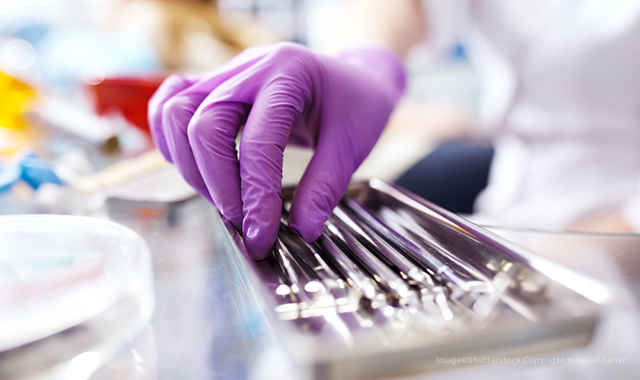How electropolishing benefits both dentists and patients
Your dental instruments are at risk of corrosion, but this electro-chemical process can stop the damage in its tracks.

When it comes to patient health, every aspect of care should be taken to ensure the best outcomes for any treatment or procedure. In the dental industry, this is very important since dental instruments come in direct contact with a patient’s mouth. Electropolishing, an advanced electro-chemical finishing process, improves the performance of metal parts, benefiting dentists and patients alike.
A smooth and clean surface
For virtually any dental tool composed of a metal alloy, the most critical factor that impacts its overall life cycle and cost is its resistance to friction and wear.
This capacity is largely determined by the quality of the surface finish. A smooth surface finish impacts integrity and durability as well as its accuracy in performing the job for which it was created.
Because they’re used in the context of patient care, the demands made on dental instruments encompass a wider set of requirements, perhaps most important of which is ensuring that they’re properly sanitized between each use.
Trending article: The dental prescriptions that are killing your patients
The smoother the surface, such as that created by electropolishing, the more the instrument will withstand the risk of corrosion and protect patients from health risks due to the adherence of contaminants.
What is corrosion and what causes it?
Corrosion can take the form of staining, pitting or cracking. It starts with the outermost layer of an instrument and the damage slowly penetrates the underlying layers. The steam and heat of autoclaving is often thought to be the primary cause of corrosion in dental instruments.
An autoclave sterilizes, but it doesn’t clean. The heat may cause surface debris - from either the usage of the instrument or the cleaning of the instrument - to become permanently baked onto the instrument. For this reason, it’s critical that dental instruments be thoroughly cleaned of all debris before being placed in an autoclave. The American Dental Association provides information on the processing and products related to the sterilization and disinfection of dental instruments.
Something to be aware of is that the autoclave itself, if subjected to the use of tap water, which has chloride in it, can become corroded within five or six years. The use of distilled water is highly recommended as a method to ward off this type of corrosion.
Staining
The appearance of stains on instruments can be very disconcerting to patients, as these stains indicate a less-than-germ-free environment. Stains on dental instruments are typically an orange-brown color and appear similar to rust.
They’re primarily caused by chloride ions, which can be found in pus, blood, and other surgical residues and secretions. Another source of staining can simply be tap water used to remove debris; it may contain a high concentration of chloride ions as well as other minerals that can become deposited on the surface of the instruments.
Pitting corrosion
Pitting corrosion is one of the most damaging types of corrosion. Initially, it may just be one or more small, localized depressions, or pits, in the surface of the metal, but it can further penetrate the metal, creating deeper and wider pits. These pits not only weaken the metal but create crevices that can harbor contaminants and pathogens.
Stress corrosion
Stress corrosion is generally referred to as “stress corrosion cracking (SCC),” and it can occur in virtually any metal alloy. The fracturing gradually increases and is thought to be caused by a combination of tensile stress, a corrosive environment, and the structure of the instrument itself.
Read more: 5 do's and don'ts of sterilization in the dental practice
The benefits of electropolishing

Electropolishing is a process in which metal parts are submerged in a chemical bath. Current is then applied to the part, electrochemically removing metal ions from the instrument. After polishing, the part is rinsed, removing the electrolytes on the surface, and then dried.
The process leaves the surface bright, smooth and passive. The resultant surface condition inhibits contaminants from clinging to it, leaving it far less susceptible to various types of corrosion.
Repeatable, measurable precision is a key factor in the manufacture of any type of tool, and dental instruments are no different. Electropolishing provides the most consistent finish attainable because it enables manufacturers to better control the removal of surface material than any other process.
For example, “bright dip” chemical treatments can’t be precisely controlled because they become weaker and react less and less with each use. With these processes that rely on harsh chemicals alone, it’s difficult to achieve accuracy, whereas the phosphorus acid-based electrolyte in the electropolishing process is very stable and it takes much longer for it to change enough to affect the amount of surface material removed. It’s so stable that electropolishing can maintain tolerances of +/- .0001.
Finally, instruments such as drills have grooves or sharp edges and aren’t uniform in shape, making mechanical polishing techniques difficult. Immersion in the electropolishing bath ensures that every area of the surface is treated with consistency, creating a smooth surface that’s able to resist corrosion far longer and protect patient health and safety.
References
http://www.ableelectropolishing.com/industry-solutions/dental/
https://cdn2.hubspot.net/hubfs/500185/pdfs/technicalguides/AbleElectropolishing-Metal_Finishing_for_the_Dental_Industry.pdf
https://www.corrosionpedia.com
https://aboutsurgicalinstruments.wordpress.com/2012/11/07/care-of-surgical-instruments/
https://www.ada.org/~/media/ADA/Member%20Center/FIles/cdc_sterilization.ashx
https://www.juniordentist.com/corrosion-in-dentistry.html